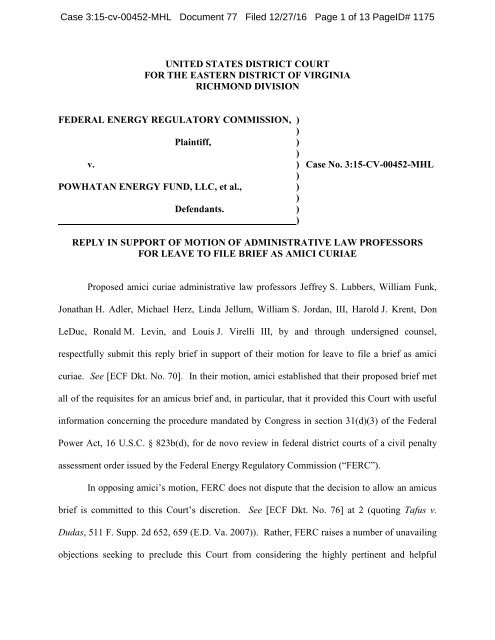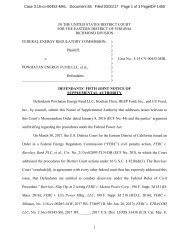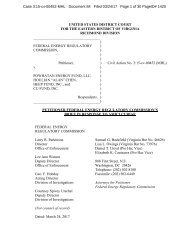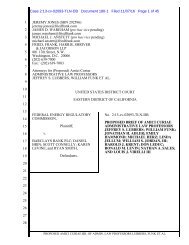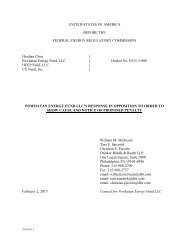Reply-ISO-Motion-for-Leave-to-File-Brief-as-Amici-Curiae
Reply-ISO-Motion-for-Leave-to-File-Brief-as-Amici-Curiae
Reply-ISO-Motion-for-Leave-to-File-Brief-as-Amici-Curiae
Create successful ePaper yourself
Turn your PDF publications into a flip-book with our unique Google optimized e-Paper software.
C<strong>as</strong>e 3:15-cv-00452-MHL Document 77 <strong>File</strong>d 12/27/16 Page 1 of 13 PageID# 1175<br />
UNITED STATES DISTRICT COURT<br />
FOR THE EASTERN DISTRICT OF VIRGINIA<br />
RICHMOND DIVISION<br />
FEDERAL ENERGY REGULATORY COMMISSION, )<br />
)<br />
Plaintiff, )<br />
)<br />
v. ) C<strong>as</strong>e No. 3:15-CV-00452-MHL<br />
)<br />
POWHATAN ENERGY FUND, LLC, et al., )<br />
)<br />
Defendants. )<br />
)<br />
REPLY IN SUPPORT OF MOTION OF ADMINISTRATIVE LAW PROFESSORS<br />
FOR LEAVE TO FILE BRIEF AS AMICI CURIAE<br />
Proposed amici curiae administrative law professors Jeffrey S. Lubbers, William Funk,<br />
Jonathan H. Adler, Michael Herz, Linda Jellum, William S. Jordan, III, Harold J. Krent, Don<br />
LeDuc, Ronald M. Levin, and Louis J. Virelli III, by and through undersigned counsel,<br />
respectfully submit this reply brief in support of their motion <strong>for</strong> leave <strong>to</strong> file a brief <strong>as</strong> amici<br />
curiae. See [ECF Dkt. No. 70]. In their motion, amici established that their proposed brief met<br />
all of the requisites <strong>for</strong> an amicus brief and, in particular, that it provided this Court with useful<br />
in<strong>for</strong>mation concerning the procedure mandated by Congress in section 31(d)(3) of the Federal<br />
Power Act, 16 U.S.C. § 823b(d), <strong>for</strong> de novo review in federal district courts of a civil penalty<br />
<strong>as</strong>sessment order issued by the Federal Energy Regula<strong>to</strong>ry Commission (“FERC”).<br />
In opposing amici’s motion, FERC does not dispute that the decision <strong>to</strong> allow an amicus<br />
brief is committed <strong>to</strong> this Court’s discretion. See [ECF Dkt. No. 76] at 2 (quoting Tafus v.<br />
Dud<strong>as</strong>, 511 F. Supp. 2d 652, 659 (E.D. Va. 2007)). Rather, FERC raises a number of unavailing<br />
objections seeking <strong>to</strong> preclude this Court from considering the highly pertinent and helpful
C<strong>as</strong>e 3:15-cv-00452-MHL Document 77 <strong>File</strong>d 12/27/16 Page 2 of 13 PageID# 1176<br />
legislative his<strong>to</strong>ry brought <strong>to</strong> this c<strong>as</strong>e by amici. As explained in their motion (see [ECF Dkt.<br />
No. 70] at 5) and <strong>as</strong> detailed in their proposed brief (see [ECF Dkt. No. 70-1] at 11-14), amici<br />
bring <strong>to</strong> the Court in<strong>for</strong>mation regarding the his<strong>to</strong>ry, meaning, and purpose of the dual scheme<br />
adopted by Congress in section 31(d) of the Federal Power Act. Because amici’s proposed brief<br />
is both timely and useful, they respectfully request that the Court grant their motion and accept<br />
their proposed brief <strong>for</strong> filing.<br />
FERC’s timeliness objection lacks merit. FERC principally objects <strong>to</strong> amici’s proposed<br />
brief <strong>as</strong> being “untimely,” citing a few instances where district courts, exercising their discretion,<br />
did not accept proposed amicus briefs on timeliness and other grounds. See [ECF Dkt. No. 76]<br />
at 3. These decisions, however, merely illustrate that the timeliness of a proposed amicus brief is<br />
but one fac<strong>to</strong>r <strong>to</strong> be considered and that, in any event, timeliness is a relative concept: The<br />
timeliness of a given brief depends on the circumstances of a particular c<strong>as</strong>e. Thus, district<br />
courts have also exercised their discretion <strong>to</strong> allow amicus briefs (over timeliness objections)<br />
where the proposed briefs were filed after the parties had completed briefing. See, e.g., Andersen<br />
v. Leavitt, No. 03-cv-6115 (DRH) (ARL), 2007 U.S. Dist. LEXIS 59108, at *13-14 (E.D.N.Y.<br />
Aug. 13, 2007) (accepting amicus brief filed five months after summary judgment briefing w<strong>as</strong><br />
completed); W<strong>as</strong>te Mgmt., Inc. v. City of York, 162 F.R.D. 34, 35-37 (M.D. Pa. 1995) (accepting<br />
amicus brief filed months after briefing w<strong>as</strong> completed). Indeed, courts accept amicus briefs<br />
filed even after the issues have been decided. See Acra Turf Club, LLC v. Zanzuccki, Civ. A.<br />
No. 12-2775 (MAS) (DEA), 2014 U.S. Dist. LEXIS 152167, at *15-16 (D.N.J. Oct. 28, 2014)<br />
(allowing amicus brief over objection after the issues had already been decided “in order <strong>to</strong><br />
preclude the possibility that a resource that could have been of <strong>as</strong>sistance is absent from the<br />
record”).<br />
2
C<strong>as</strong>e 3:15-cv-00452-MHL Document 77 <strong>File</strong>d 12/27/16 Page 3 of 13 PageID# 1177<br />
The salient question, <strong>as</strong> illustrated by all of these examples, is whether accepting the<br />
proposed amicus brief, on balance, will unnecessarily delay the proceedings.<br />
See, e.g.,<br />
Andersen, 2007 U.S. Dist. LEXIS 59108, at *7 (observing that parties “should have their dispute<br />
resolved without any unnecessary delay” and accepting amicus brief where it would not delay<br />
the proceedings (quotation marks and citation omitted)); Bryant v. New Jersey DOT, 987<br />
F. Supp. 343, 346 n.3 (D.N.J. 1998) (accepting amicus brief over objection where its<br />
consideration did not delay the c<strong>as</strong>e and the brief provided “considerable <strong>as</strong>sistance” <strong>to</strong> the<br />
court), vacated in part on other grounds, 998 F. Supp. 438 (D.N.J. 1998); Fluor Corp. v. United<br />
States, 35 Fed. Cl. 284, 286 (1996) (concluding that, where the acceptance of an amicus brief<br />
that “would not unre<strong>as</strong>onably delay the litigation,” that fac<strong>to</strong>r weighs in favor of allowing the<br />
brief).<br />
Here, and <strong>as</strong> explained in their motion (see [ECF Dkt. No. 70] at 5), amici respectfully<br />
submit that allowing their proposed brief need not materially delay this c<strong>as</strong>e, if at all. Although<br />
the Court h<strong>as</strong> taken the issues under advisement, the Court h<strong>as</strong> not ruled on the pending question<br />
of the appropriate procedures <strong>for</strong> this Court’s de novo review under section 31(d). <strong>Amici</strong>’s<br />
proposed brief h<strong>as</strong> already been lodged with the Court (see [ECF Dkt. No. 70-1]) and there<strong>for</strong>e<br />
can be considered by the Court without delay. And, although FERC chose not <strong>to</strong> avail itself of<br />
the opportunity <strong>to</strong> address the substance of amici’s proposed brief in its opposition, the Court<br />
could set a relatively short briefing schedule <strong>for</strong> such a response if the Court accepts FERC’s<br />
proposal (see [ECF Dkt. No. 76] at 7) <strong>to</strong> allow a “responsive brief of no more than 20 pages.”<br />
FERC h<strong>as</strong> not suggested that it would suffer any undue prejudice if the Court were <strong>to</strong> allow such<br />
a response.<br />
3
C<strong>as</strong>e 3:15-cv-00452-MHL Document 77 <strong>File</strong>d 12/27/16 Page 4 of 13 PageID# 1178<br />
In short, amici’s proposed brief is timely, and its consideration by the Court need not<br />
unnecessarily delay this c<strong>as</strong>e.<br />
FERC ignores the useful in<strong>for</strong>mation in the proposed brief. FERC also objects <strong>to</strong> the<br />
proposed brief <strong>as</strong> being “unhelpful” on a number of grounds. Of course, FERC’s view that the<br />
proposed brief may not be helpful <strong>to</strong> its position in this litigation does not render the proposed<br />
brief unhelpful <strong>to</strong> the Court. On this score, amici respectfully submit that their proposed brief<br />
provides highly useful in<strong>for</strong>mation not previously presented <strong>to</strong> the Court in these proceedings.<br />
“The primary re<strong>as</strong>on <strong>to</strong> allow amicus curiae briefing is that the amicus curiae ‘offer<br />
insights not available from the parties,’ thereby aiding the Court.” Andersen, 2007 U.S. Dist.<br />
LEXIS 59108, at *6 (quoting Citizens Against C<strong>as</strong>ino Gambling in Erie Cty. v. Kempthorne, 471<br />
F. Supp. 2d 295, 311 (W.D.N.Y. 2007)). This Court previously <strong>as</strong>ked the parties <strong>to</strong> address,<br />
inter alia, “[w]hether legislative his<strong>to</strong>ry of § 823b(d) exists, and whether such in<strong>for</strong>mation sheds<br />
light on the interpretation of the statute.” [ECF Dkt. No. 44] at 3. In response <strong>to</strong> that request, the<br />
parties submitted briefs canv<strong>as</strong>sing the legislative his<strong>to</strong>ry of the Federal Power Act and other<br />
statutes. See [ECF Dkt. No. 52] at 1-11; [ECF Dkt. No. 53] at 4-5. <strong>Amici</strong>’s proposed brief does<br />
not duplicate that ef<strong>for</strong>t; rather, amici supplement it by pointing the Court <strong>to</strong> the text and<br />
legislative his<strong>to</strong>ry of the National Energy Conservation Policy Act of 1978 and the Powerplant<br />
and Industrial Fuel Use Act of 1978 -- two statutes in which Congress used the very same “de<br />
novo review” <strong>for</strong>mulation <strong>as</strong> later found in section 31(d) of the Federal Power Act. See [ECF<br />
Dkt. No. 70-1] at 11-14; see also 42 U.S.C. § 6303(d)(3)(B) (“[T]he Secretary shall institute an<br />
action in the appropriate district court of the United States <strong>for</strong> an order affirming the <strong>as</strong>sessment<br />
of the civil penalty. The court shall have authority <strong>to</strong> review de novo the law and the facts<br />
involved, and shall have jurisdiction <strong>to</strong> enter a judgment en<strong>for</strong>cing, modifying, and en<strong>for</strong>cing <strong>as</strong><br />
4
C<strong>as</strong>e 3:15-cv-00452-MHL Document 77 <strong>File</strong>d 12/27/16 Page 5 of 13 PageID# 1179<br />
so modified, or setting <strong>as</strong>ide in whole or in part, such <strong>as</strong>sessment.”); 42 U.S.C. § 8433(d)(3)(B)<br />
(same).<br />
FERC attempts <strong>to</strong> dismiss the proposed brief’s discussion of these two statutes <strong>as</strong><br />
involving “statutes not at issue in the current proceeding” ([ECF Dkt. No. 76] at 4), but the<br />
his<strong>to</strong>ries of these statutes and the import of the similar language used by Congress in the<br />
National Energy Conservation Policy Act of 1978, the Powerplant and Industrial Fuel Use Act of<br />
1978, and the Federal Power Act cannot be so e<strong>as</strong>ily dismissed. Indeed, the similarity of the<br />
language in these three statutes is, at the very le<strong>as</strong>t, highly probative that the language shares a<br />
common meaning. See, e.g., Northcross v. Bd. of Educ. of the Memphis City Schs., 412 U.S.<br />
427, 428 (1973) (per curiam) (“The similarity of language in § 718 [of the Emergency School<br />
Aid Act of 1972, 86 Stat. 369, 20 U.S.C. § 1617] and § 204(b) [the Civil Rights Act of 1964, 78<br />
Stat. 244, 42 U.S.C. § 2000a-3(b)] is, of course, a strong indication that the two statutes should<br />
be interpreted pari p<strong>as</strong>su.”); Welsh v. United States, 398 U.S. 333, 351 (1970) (Harlan, J.,<br />
concurring) (“In the realm of statu<strong>to</strong>ry construction it is appropriate <strong>to</strong> search <strong>for</strong> meaning in the<br />
congressional vocabulary in a lexicon most probably consulted by Congress.”).<br />
In response <strong>to</strong> this Court’s inquiry regarding the legislative his<strong>to</strong>ry of section 31(d) of the<br />
Federal Power Act, none of the parties pointed this Court <strong>to</strong> the National Energy Conservation<br />
Policy Act of 1978 or the Powerplant and Industrial Fuel Use Act of 1978. For its part, FERC<br />
pointed this Court <strong>to</strong> a number of different statutes, including the Employee Retirement Income<br />
Security Act of 1974, the Immigration and Nationality Act, the Bank Merger Act of 1966, and<br />
the Sarbanes-Oxley Act of 2002). See [ECF Dkt. No. 52] at 7-11; see also [ECF Dkt. No. 39]<br />
at 27 n.29 (discussing the Individuals with Disabilities Education Act and the Gun Control Act.).<br />
As FERC h<strong>as</strong> framed its discussion of these other statutes, “[n]umerous statutes could be<br />
5
C<strong>as</strong>e 3:15-cv-00452-MHL Document 77 <strong>File</strong>d 12/27/16 Page 6 of 13 PageID# 1180<br />
analogized in some way <strong>to</strong> the FPA, but few directing a ‘review de novo’ and even fewer that<br />
have given rise <strong>to</strong> c<strong>as</strong>e law that would allow inferences <strong>to</strong> be drawn about the meaning of FPA<br />
§ 823b(d)(3).” [ECF Dkt. No. 52] at 6.<br />
As explained in more detail in their proposed brief (see [ECF Dkt. No. 70-1] at 14), amici<br />
believe that, <strong>as</strong> just one example, the conference report <strong>for</strong> the National Energy Conservation<br />
Policy Act provides far more relevant in<strong>for</strong>mation that “would allow <strong>for</strong> inferences <strong>to</strong> be drawn<br />
about the meaning of” section 31(d) of the Federal Power Act, where it is specifically explained<br />
in that conference report that, although the statu<strong>to</strong>ry language adopted by Congress “says that<br />
‘the court shall have authority <strong>to</strong> review de novo the law and facts involved, . . .’ the conferees<br />
fully intend that the party electing the de novo review procedure is entitled <strong>to</strong> such review, and<br />
the scope of review used by the district court under this provision shall be no other than a de<br />
novo review of the facts and issues pleaded.” H.R. Rep. No. 95-1751, at 117 (1978), reprinted in<br />
1978 U.S.C.C.A.N. 8134, 8161, also available at http://hdl.handle.net/2027/mdp.<br />
39015087614510?urlappend=%3Bseq=1153. Thus, amici respectfully submit that the legislative<br />
his<strong>to</strong>ries of the National Energy Conservation Policy Act of 1978 and the Powerplant and<br />
Industrial Fuel Use Act of 1978 -- where Congress employed the very same de novo review<br />
procedure <strong>as</strong> found in the Federal Power Act -- provide far more relevant context than any of the<br />
other his<strong>to</strong>ries previously cited <strong>to</strong> this Court.<br />
FERC also insists that the proposed brief from amici is not helpful because the<br />
defendants in this c<strong>as</strong>e are well represented. See [ECF Dkt. No. 76] at 4. This argument is a non<br />
sequitur.<br />
Even when the parties are well represented, “an amicus may provide important<br />
<strong>as</strong>sistance <strong>to</strong> the court.” Jamul Action Comm. v. Stevens, No. 2:13-cv-01920-KJM-KJN, 2014<br />
U.S. Dist. LEXIS 107582, at *13-15 (E.D. Cal. Aug. 5, 2014) (quotation omitted); see also<br />
6
C<strong>as</strong>e 3:15-cv-00452-MHL Document 77 <strong>File</strong>d 12/27/16 Page 7 of 13 PageID# 1181<br />
Neona<strong>to</strong>logy Assocs., P.A. v. Comm’r of Internal Revenue, 293 F.3d 128, 132 (3d Cir. 2002)<br />
(Ali<strong>to</strong>, J.) (explaining that, “[e]ven when a party is very well represented, an amicus may provide<br />
important <strong>as</strong>sistance <strong>to</strong> the court”); Canamar v. McMillin Tex. Mgmt. Servs., LLC, Civ. A.<br />
No. SA-08-CV-0516 FB, 2009 U.S. Dist. LEXIS 108986, at *3 (W.D. Tex. Nov. 20, 1999)<br />
(accepting amicus brief over opposition where “the in<strong>for</strong>mation supplied is potentially useful <strong>to</strong><br />
the Court and beyond that which the parties themselves have provided in their extensive<br />
briefing”). As then-Circuit Judge Ali<strong>to</strong> observed in Neona<strong>to</strong>logy Associates, “denying motions<br />
<strong>for</strong> leave <strong>to</strong> file an amicus brief whenever the party supported is adequately represented would in<br />
some instances deprive the court of valuable <strong>as</strong>sistance.” 293 F.3d at 132 (endorsing the view<br />
that “[s]ome amicus briefs collect background or factual references that merit judicial notice”<br />
and “[s]ome friends of the court are entities with particular expertise not possessed by any party<br />
<strong>to</strong> the c<strong>as</strong>e.” (quotation marks and citation omitted)). Here, amici, <strong>as</strong> experts in administrative<br />
law, bring <strong>to</strong> this Court a useful perspective and highly relevant background in<strong>for</strong>mation not<br />
previously addressed by the parties. This in<strong>for</strong>mation merits this Court’s attention, regardless of<br />
whether the parties in this c<strong>as</strong>e are well represented.<br />
FERC also complains that the proposed brief “does not provide useful legal analysis<br />
materially different from that contained in Respondents’ own briefing.” [ECF Dkt. No. 76] at 4<br />
(citing the discussion in the proposed brief of amicus Professor William Funk’s research). This<br />
complaint is plainly wrong. The one example of purported “duplication” cited by FERC is the<br />
discussion of Professor Funk’s research that had previously been discussed by the defendants in<br />
this c<strong>as</strong>e (see [ECF Dkt. No. 76] at 4), but the discussion in the proposed brief w<strong>as</strong> plainly part of<br />
a broader discussion of the his<strong>to</strong>rical background of the administrative <strong>as</strong>sessment of civil money<br />
penalties, <strong>as</strong> indicated by the heading title <strong>for</strong> that section of the brief. See [Dkt. No. 70-1] at 4<br />
7
C<strong>as</strong>e 3:15-cv-00452-MHL Document 77 <strong>File</strong>d 12/27/16 Page 8 of 13 PageID# 1182<br />
(“The His<strong>to</strong>rical Background Of Administrative Assessment Of Civil Money Penalties”). In<br />
contr<strong>as</strong>t, FERC h<strong>as</strong> not pointed <strong>to</strong> any discussion of the National Energy Conservation Policy<br />
Act of 1978 or the Powerplant and Industrial Fuel Use Act of 1978 in any of the prior<br />
submissions of the parties in this c<strong>as</strong>e, so FERC’s objection rings hollow. (In any event, <strong>to</strong> the<br />
extent FERC is correct that the proposed brief is in any way duplicative, FERC could not be<br />
prejudiced by such alleged duplication.)<br />
As established in the motion, amici’s proposed brief is useful and provides this Court<br />
with highly relevant in<strong>for</strong>mation on the meaning of section 31(d) that had not previously been<br />
brought <strong>to</strong> this Court’s attention. This Court should reject FERC’s attempts at keeping this<br />
in<strong>for</strong>mation from the Court’s consideration.<br />
FERC’s improperly narrow conception of the role of amicus curiae should be rejected.<br />
FERC does not question the expertise of amici, nor does it question their interest, <strong>as</strong> scholars of<br />
administrative law, in the proper development of the law. Rather, FERC argues that amici have<br />
“no special interest in this c<strong>as</strong>e <strong>to</strong> justify their input” ([ECF Dkt. No. 76] at 5), <strong>as</strong> if this is a<br />
specific threshold requirement <strong>for</strong> accepting the proposed brief from amici. The circumstances<br />
where an amicus curiae may be appropriate are much broader, however, and amici have “‘been<br />
allowed at the trial level where they provide helpful analysis of the law, they have a special<br />
interest in the subject matter of the suit, or existing counsel is in need of <strong>as</strong>sistance.’” Tafus, 511<br />
F. Supp. 2d at 659 (emph<strong>as</strong>is added) (quoting Bryant v. Better Bus. Bureau of Greater Md., Inc.,<br />
923 F. Supp. 720, 728 (D. Md. 1996)).<br />
Law professors like amici here routinely appear <strong>as</strong> amici curiae in federal courts. See,<br />
e.g., Garcia v. Google, Inc., 786 F.3d 733, 739 n.3 (9th Cir. 2015) (en banc) (amicus brief filed<br />
by copyright and Internet law scholars); Enron Corp. v. Springfield Assocs., L.L.C. (In re Enron<br />
8
C<strong>as</strong>e 3:15-cv-00452-MHL Document 77 <strong>File</strong>d 12/27/16 Page 9 of 13 PageID# 1183<br />
Corp.), 379 B.R. 425, 431 (S.D.N.Y. 2007) (bankruptcy professor); 321 Studios v. MGM Studios,<br />
Inc., 307 F. Supp. 2d 1085, 1106-07 (N.D. Cal. 2004) (copyright law professors).<br />
FERC<br />
discounts the input of such experts, quoting in its opposition the majority decision in American<br />
College of Obstetricians & Gynecologists v. Thornburgh, 699 F.2d 644 (3d Cir. 1983), where a<br />
sharply divided panel rejected a proposed amicus curiae brief filed by law professors. See [ECF<br />
Dkt. No. 76] at 5-6. The analysis of the panel majority in that c<strong>as</strong>e is dubious. See Neona<strong>to</strong>logy<br />
Assocs., 293 F.3d at 130 (questioning the correctness of the majority’s analysis); see also Am.<br />
Coll., 699 F.2d at 645 (Higginbotham, J., dissenting) (“H.G. Wells once wrote ‘That civilization<br />
is a race between education and cat<strong>as</strong>trophe.’ I submit that, even in a court <strong>as</strong> learned <strong>as</strong> ours,<br />
we might be able <strong>to</strong> avoid some unnecessary cat<strong>as</strong>trophes if we have the will and the patience <strong>to</strong><br />
listen <strong>to</strong> legal educa<strong>to</strong>rs.”). In any event, that analysis is not binding on this Court and, in light<br />
of the sheer number of amicus briefs filed by law professors that are routinely accepted by<br />
federal courts, obviously does not represent a consensus view. Cf. Neona<strong>to</strong>logy Assocs., 293<br />
F.3d at 130 (noting that “the appellants cite a small body of judicial opinions that look with<br />
disfavor on motions <strong>for</strong> leave <strong>to</strong> file amicus briefs” and ultimately rejecting that view).<br />
FERC also hints that the proposed brief is improper, citing then-Chief Judge Posner’s<br />
observation that some types of amicus briefs should not be allowed. [ECF Dkt. No. 76] at 6<br />
(quoting Ryan v. Futures Trading Comm’n, 125 F.3d 1062, 1063 (7th Cir 1997) (Posner, C.J., in<br />
chambers)). But the proposed brief from amici in this c<strong>as</strong>e falls squarely within even Judge<br />
Posner’s conception of an appropriate amicus brief -- i.e., a brief that points judges <strong>to</strong><br />
“considerations germane <strong>to</strong> our decision . . . that the parties <strong>for</strong> one re<strong>as</strong>on or another have not<br />
brought <strong>to</strong> our attention.” Ryan, 125 F.3d at 1064. FERC’s objections, there<strong>for</strong>e, should be<br />
rejected.<br />
9
C<strong>as</strong>e 3:15-cv-00452-MHL Document 77 <strong>File</strong>d 12/27/16 Page 10 of 13 PageID# 1184<br />
* * *<br />
In the end, the appropriate “<strong>to</strong>uchs<strong>to</strong>ne is whether the amicus is ‘helpful,’” Cal. v. U.S.<br />
Dep’t of Labor, No. 2:13-CV-02069-KJM-DAD, 2014 U.S. Dist. LEXIS 5439, at *3 (E.D. Cal.<br />
Jan. 14, 2014) (citation omitted), and when the proposed brief meets these standards, the amicus<br />
brief “should normally be allowed,” Cmty. Ass’n <strong>for</strong> Res<strong>to</strong>ration of the Env’t (CARE) v.<br />
DeRuyter Bros. Dairy, 54 F. Supp. 2d 974, 975 (E.D. W<strong>as</strong>h. 1999). Because amici’s proposed<br />
brief is timely and provides useful in<strong>for</strong>mation not previously brought <strong>to</strong> this Court’s attention,<br />
amici respectfully submit that this Court should grant their motion, accept the proposed brief <strong>for</strong><br />
filing, and decide the question of what procedures are required under Section 31(d) with all<br />
relevant resources available <strong>to</strong> the Court.<br />
Dated: December 27, 2016<br />
Respectfully submitted,<br />
/s/ James E. Anklam<br />
James E. Anklam (VSB # 27976)<br />
James D. Wareham (pro hac vice)<br />
Michael J. Anstett (pro hac vice)<br />
FRIED, FRANK, HARRIS, SHRIVER<br />
& JACOBSON LLP<br />
801 17th Street, N.W.<br />
W<strong>as</strong>hing<strong>to</strong>n, D.C. 20006<br />
Telephone: 202-639-7000<br />
Facsimile: 202-639-7003<br />
James.Anklam@friedfrank.com<br />
James.Wareham@friedfrank.com<br />
Michael.Anstett@friedfrank.com<br />
Counsel <strong>to</strong> (Proposed) <strong>Amici</strong> <strong>Curiae</strong><br />
Jeffrey S. Lubbers<br />
Professor of Practice in Administrative Law<br />
American University, W<strong>as</strong>hing<strong>to</strong>n College of Law<br />
William Funk<br />
Lewis & Clark Distinguished Professor of Law<br />
Lewis & Clark Law School<br />
10
C<strong>as</strong>e 3:15-cv-00452-MHL Document 77 <strong>File</strong>d 12/27/16 Page 11 of 13 PageID# 1185<br />
Jonathan H. Adler<br />
Johan Verheij Memorial Professor of Law<br />
Direc<strong>to</strong>r, Center <strong>for</strong> Business Law & Regulation<br />
C<strong>as</strong>e Western Reserve University School of Law<br />
Michael Herz<br />
Arthur Kaplan Professor of Law<br />
Benjamin Cardozo School of Law<br />
Yeshiva University<br />
Linda Jellum<br />
Ellison C. Palmer Professor of Tax Law<br />
Mercer University School of Law<br />
William S. Jordan, III<br />
C. Blake McDowell Professor of Law<br />
The University of Akron School of Law<br />
Harold J. Krent<br />
Dean and Professor of Law<br />
IIT Chicago-Kent College of Law<br />
Don LeDuc<br />
President, Dean and Professor<br />
Western Michigan University Thom<strong>as</strong> M. Cooley<br />
Law School<br />
Ronald M. Levin<br />
William R. Orthwein Distinguished Professor of<br />
Law<br />
W<strong>as</strong>hing<strong>to</strong>n University School of Law<br />
Louis J. Virelli III<br />
Professor of Law<br />
Stetson University College of Law<br />
(The amici’s institutional affiliations are provided<br />
<strong>for</strong> identification purposes only.)<br />
11
C<strong>as</strong>e 3:15-cv-00452-MHL Document 77 <strong>File</strong>d 12/27/16 Page 12 of 13 PageID# 1186<br />
CERTIFICATE OF SERVICE<br />
I hereby certify that, on this 27th day of December 2016, I electronically filed with the<br />
Clerk the <strong>for</strong>egoing using the Court’s Electronic CM/ECF System and that service w<strong>as</strong> thereby<br />
accomplished upon:<br />
Counsel <strong>for</strong> Powhatan Energy Fund, LLC:<br />
John Staige Davis, V (VA Bar No. 72420)<br />
Jonathan T. Lucier (VA Bar No. 81303)<br />
WILLIAMS MULLEN<br />
200 South 10th Street, Suite 1600<br />
Richmond, VA 23219<br />
Telephone: 804-420-6000<br />
Facsimile: 804-420-6507<br />
jsdavis@williamsmullen.com<br />
jtlucier@williamsmullen.com<br />
William M. McSwain (pro hac vice)<br />
Christian E. Piccolo (pro hac vice)<br />
DRINKER BIDDLE & REATH LLP<br />
One Logan Square, Suite 2000<br />
Philadelphia, PA 19103-6996<br />
Telephone: 215-988-2700<br />
Facsimile: 215-988-2757<br />
william.mcswain@dbr.com<br />
Christian.piccolo@dbr.com<br />
Counsel <strong>for</strong> Defendant Houlian Chen, HEEP Fund, Inc., and CU Fund, Inc.:<br />
John N. Estes III (pro hac vice)<br />
Donna M. Byrne (pro hac vice)<br />
James Danly (VA Bar No. 86016)<br />
SKADDEN, ARPS, SLATE, MEAGHER<br />
& FLOM LLP<br />
1440 New York Avenue, N.W.<br />
W<strong>as</strong>hing<strong>to</strong>n, DC 20005<br />
Telephone: 202-371-7000<br />
Facsimile: 202-661-8213<br />
john.estes@skadden.com<br />
donna.byrne@skadden.com<br />
james.danly@skadden.com<br />
Abbe David Lowell (pro hac vice)<br />
Michael Bhargava (pro hac vice)<br />
CHADBOURNE & PARKE LLP<br />
1200 New Hampshire Avenue, N.W.<br />
W<strong>as</strong>hing<strong>to</strong>n, DC 20036<br />
Telephone: 202-974-5605<br />
Facsimile: 202-974-6705<br />
adlowell@chadbourne.com<br />
mbhargava@chadbourne.com
C<strong>as</strong>e 3:15-cv-00452-MHL Document 77 <strong>File</strong>d 12/27/16 Page 13 of 13 PageID# 1187<br />
Counsel <strong>for</strong> Plaintiff Federal Energy Regula<strong>to</strong>ry Commission:<br />
Samuel G. Backfield<br />
Lisa Owings<br />
Steven C. Tabackman<br />
Federal Energy Regula<strong>to</strong>ry Commission<br />
888 1st Street, N.W.<br />
W<strong>as</strong>hing<strong>to</strong>n, DC 20426<br />
Telephone: 202-502-8100<br />
Facsimile: 202-502-6449<br />
Samuel.Backfield@ferc.gov<br />
Lisa.Owings@ferc.gov<br />
Steven.Tabackman@ferc.gov<br />
/s/ James E. Anklam<br />
James E. Anklam (VSB # 27976)<br />
James D. Wareham (pro hac vice)<br />
Michael J. Anstett (pro hac vice)<br />
FRIED, FRANK, HARRIS, SHRIVER<br />
& JACOBSON LLP<br />
801 17th Street, N.W.<br />
W<strong>as</strong>hing<strong>to</strong>n, D.C. 20006<br />
Telephone: 202-639-7000<br />
Facsimile: 202-639-7003<br />
James.Anklam@friedfrank.com<br />
James.Wareham@friedfrank.com<br />
Michael.Anstett@friedfrank.com<br />
Counsel <strong>to</strong> (Proposed) <strong>Amici</strong> <strong>Curiae</strong> Administrative<br />
Law Professors<br />
2


